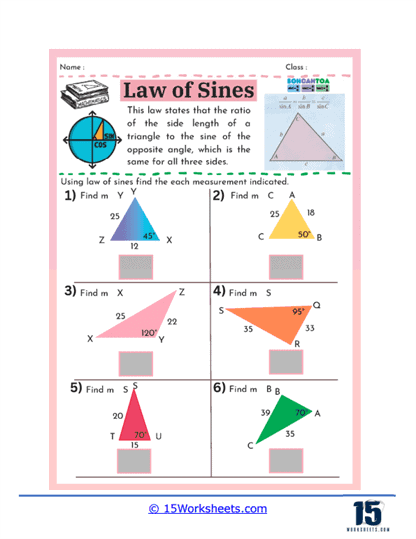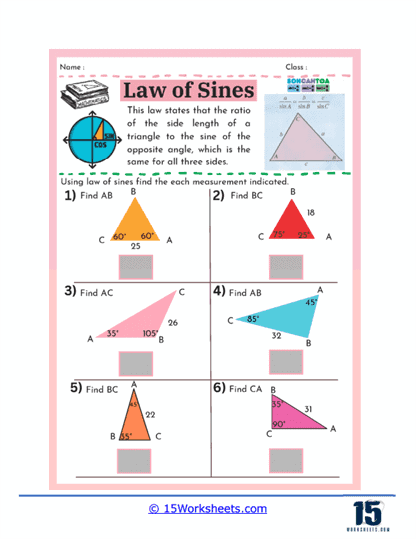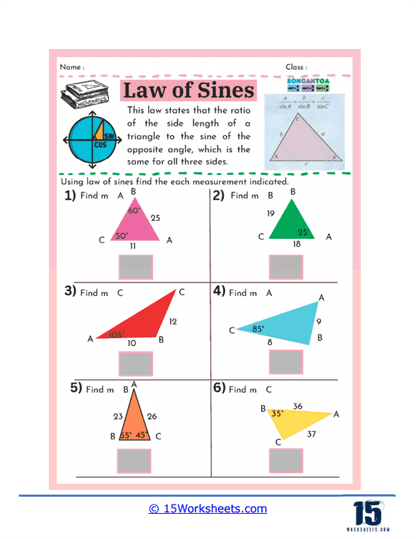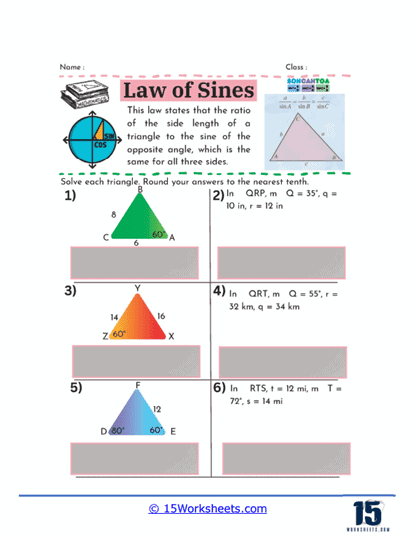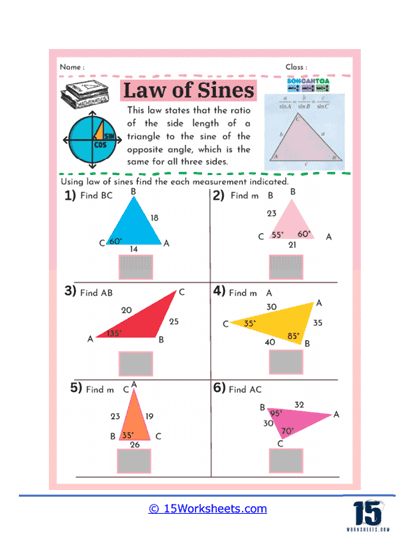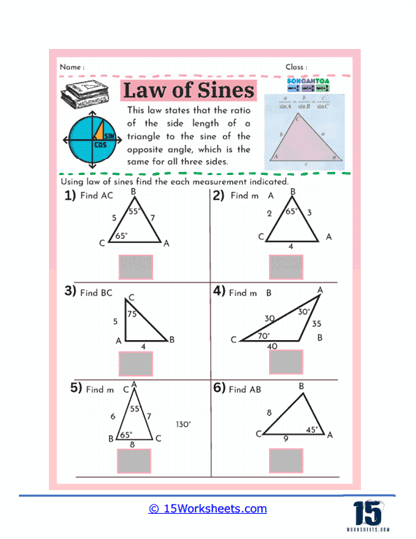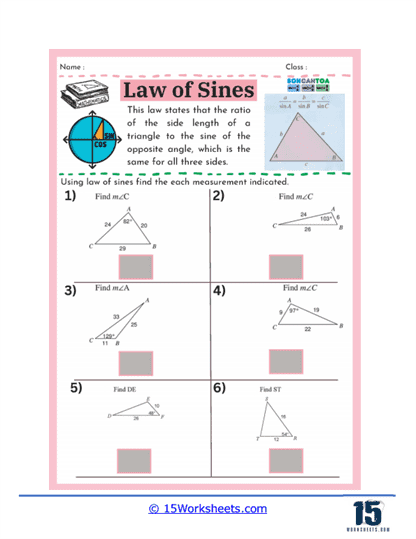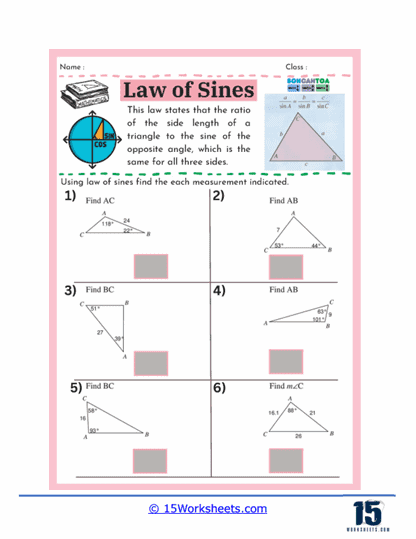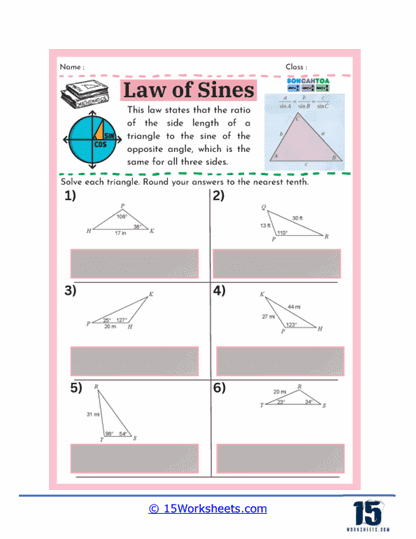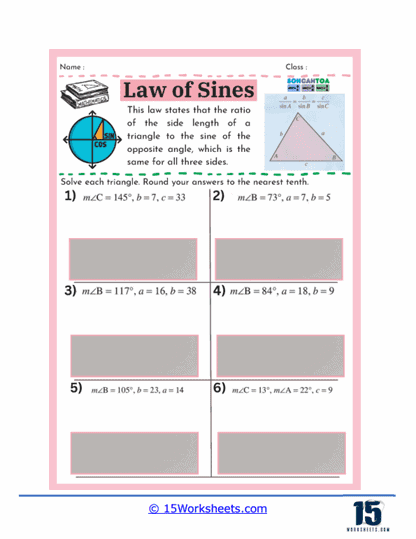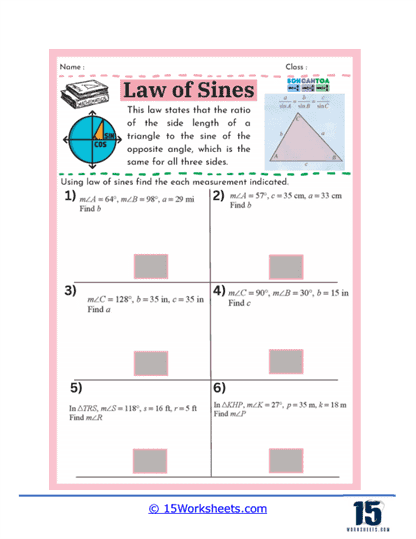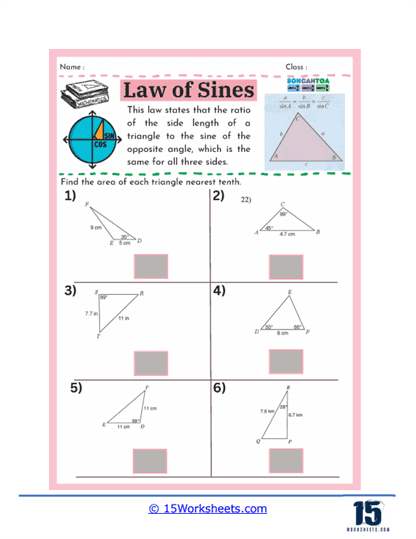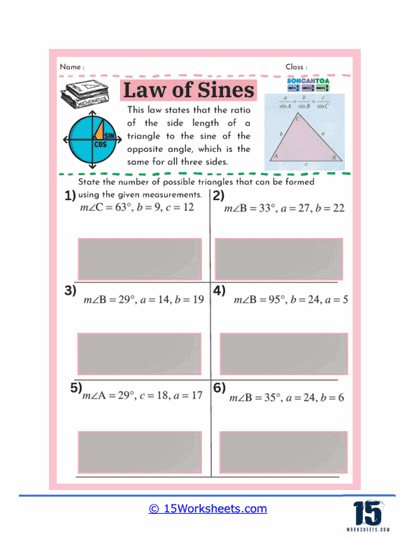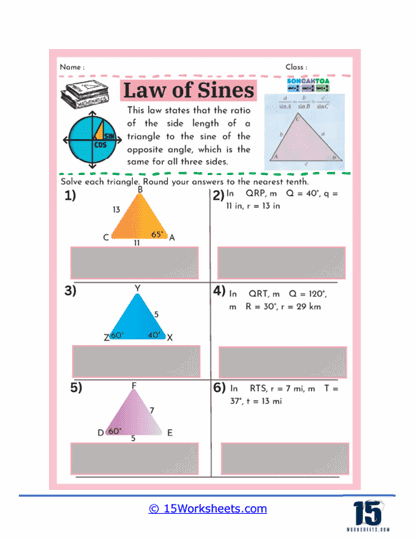Law of Sines Worksheets
About These 15 Worksheets
The Law of Sines is a fundamental concept in trigonometry, essential for solving problems related to non-right triangles. Worksheets that focus on the Law of Sines are designed to help students understand and apply this principle to various types of problems, gradually increasing in complexity. These worksheets are not just about rote learning but encourage students to engage with the material through a variety of problem types, enhancing their mathematical reasoning and problem-solving skills.
The worksheets in this collection generally start with introductory problems where students are required to find unknown sides or angles in a triangle given some known values. These problems typically provide a clear illustration of the triangle with labeled sides and angles, making it easier for students to apply the Law of Sines. The Law of Sines states that in any triangle, the ratio of the length of a side to the sine of its opposite angle is the same for all three sides.
As students progress, the worksheets present more challenging problems, such as those involving obtuse angles or requiring the use of inverse trigonometric functions to solve for an angle when the sides are known. These problems help students become comfortable with using the Law of Sines in different scenarios and ensure that they understand the underlying concepts rather than just memorizing a formula.
Another common type of worksheet problem involves determining whether a set of given measurements forms a valid triangle. This requires students to check if the given sides and angles satisfy the Law of Sines, reinforcing the concept that the law only applies to valid triangles.
Beyond basic problem-solving, some worksheets introduce real-world applications where the Law of Sines is used to solve practical problems. For example, students might be asked to determine the height of a building or the distance across a river using angle measurements and known distances. These problems show students the relevance of trigonometry in everyday situations and help them appreciate the practical applications of what they are learning.
Advanced worksheets might explore the ambiguities that arise in the Law of Sines, such as the “ambiguous case” when two different triangles could be formed with the given information. These problems are particularly engaging as they require students to think critically and consider all possible solutions rather than just following a straightforward procedure.
You will also find scenario based word problems in this set. These typically present a scenario where students must first interpret the problem, determine the relevant triangle, and then apply the Law of Sines to find the solution. These problems build critical thinking skills as students learn to translate words into mathematical equations.
Throughout these worksheets, students develop several key mathematical skills. First and foremost is the ability to apply the Law of Sines correctly in a variety of contexts. However, these worksheets also help students develop a deeper understanding of trigonometric functions, the properties of triangles, and the relationships between angles and sides. Additionally, students enhance their problem-solving abilities by tackling more complex problems that require multiple steps and a clear understanding of when and how to use the Law of Sines.
What is the Law of Sines?
The Law of Sines is a fundamental concept in trigonometry that allows us to relate the angles of a triangle to the lengths of its sides. It provides a powerful tool for solving triangles that are not right-angled, making it essential for understanding and solving problems involving non-right triangles. The law states that in any given triangle, the ratio between the length of a side and the sine of the angle opposite that side is constant for all three sides of the triangle. This relationship allows us to calculate unknown angles or sides when certain other elements of the triangle are known.
In practical terms, it is incredibly useful in a variety of real-world situations where direct measurement of distances or angles is difficult or impossible. For example, in navigation and surveying, the Law of Sines can be used to determine the distance between two points when it’s impossible to measure the distance directly. This is particularly important in areas like land surveying, where surveyors need to calculate distances across rough terrain or large bodies of water. By measuring the angles from two known points to a third point and knowing the distance between the two known points, the surveyor can calculate the distance to the third point without needing to traverse the difficult terrain.
Another real-world application of the Law of Sines is in astronomy, where it helps in determining the position of celestial objects. For instance, astronomers use the law to calculate the distance to stars or planets by measuring angles from two different locations on Earth. This method, known as triangulation, is crucial for mapping the universe and understanding the vast distances between celestial bodies.
In engineering, particularly in fields like civil and mechanical engineering, the Law of Sines is used to solve problems involving forces acting at an angle. For example, when designing structures that need to withstand forces from different directions, such as bridges or cranes, engineers use the law to calculate the magnitude and direction of the resulting forces. This ensures that the structure is stable and can safely bear the loads it’s expected to carry.
The Law of Sines plays a role in computer graphics, especially in rendering three-dimensional objects. When creating realistic images or animations, it’s often necessary to calculate the angles and lengths of various components of a 3D model to ensure that they are displayed correctly on a 2D screen. The Law of Sines helps in these calculations, ensuring that the objects look proportionate and realistic from all angles.


